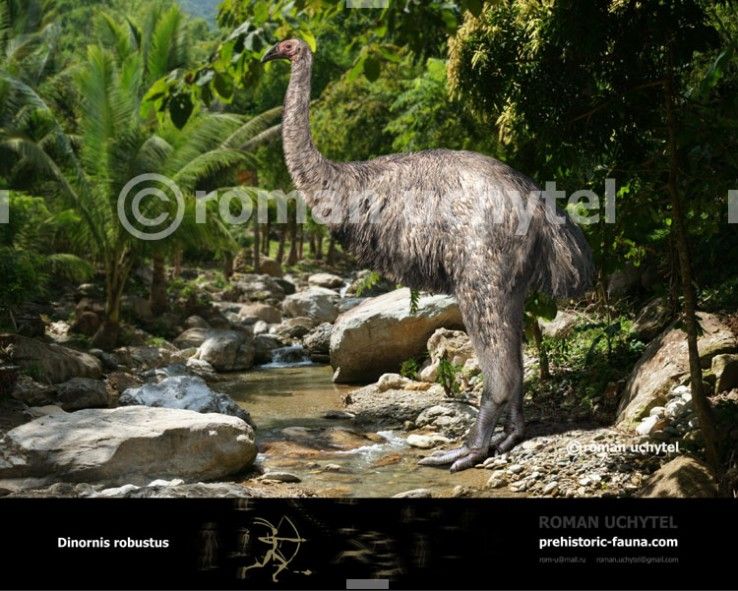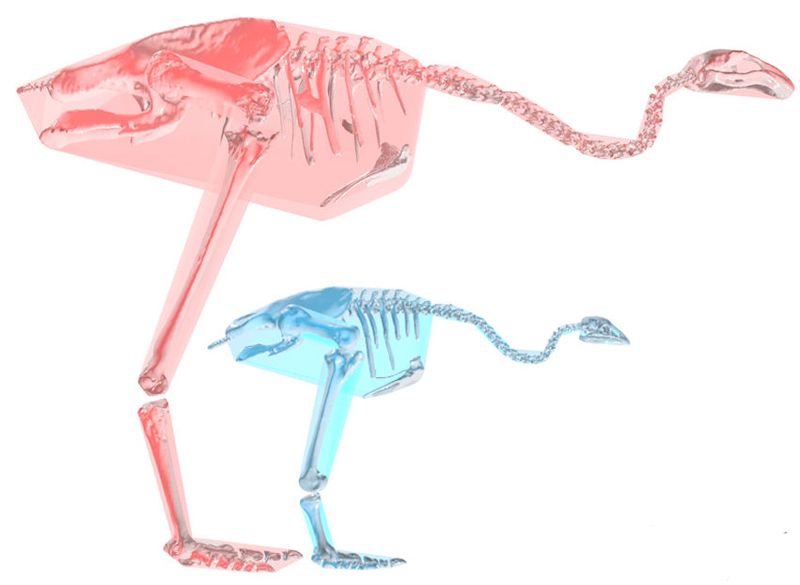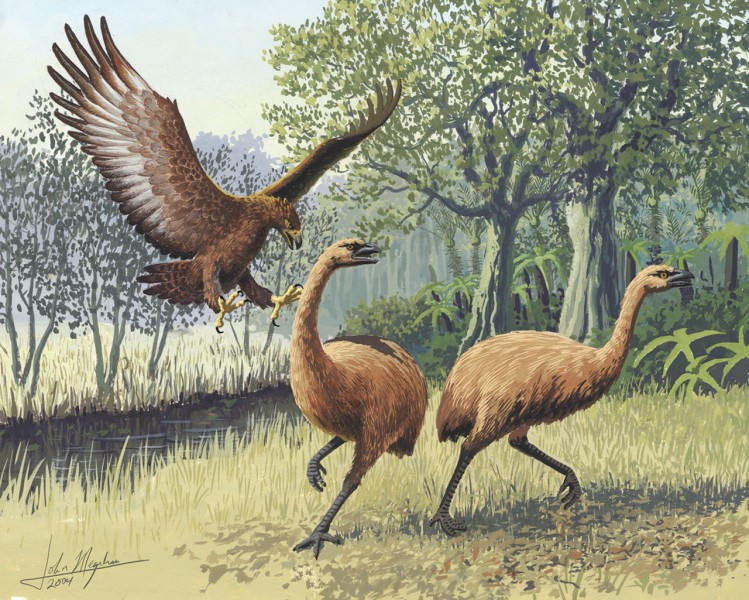Post by Eaglehawk on Jul 8, 2019 12:40:18 GMT
South Island Giant Moa - Dinornis robustus

Scientific classification
Kingdom:Animalia
Phylum:Chordata
Class:Aves
Superorder:Paleognathae
Order:Dinornithiformes
Family:Dinornithidae
Genus:Dinornis
Species:Dinornis robustus
The South Island Giant Moa, Dinornis robustus is a member of the Moa family. It was a ratite and a member of the Struthioniformes Order. The Struthioniformes are flightless birds with a sternum without a keel. They also have a distinctive palate. The origin of these birds is becoming clearer as it is now believed that early ancestors of these birds were able to fly and flew to the southern areas in which they have been found.
South Island giant moa was the biggest of them all. Adult females stood up to 2 metres high at the back, and could reach foliage up to 3.6 metres off the ground, making them the tallest bird species known. (Found on Szabo, M.J. 2013. South Island giant moa. In Miskelly, C.M. (ed.) New Zealand Birds Online. http://www.nzbirdsonline.org.nz)
It lived on the South Island of New Zealand, and its habitat was the lowlands (shrubland, duneland, grassland, and forests).
Extinct Giant Moa Bird Loses Weight, Strength, in New Study
By Laura Poppick, Staff Writer | December 18, 2013 07:01pm ET

A computer model of D. robustus (pink) next to the much smaller but more skeletally robust P. australis.
The extinct giant moa — one of the tallest birds that ever lived — may not have been as massive and strong-boned as previously thought, according to new research.
The scientific name of the giant moa — Dinornis robustus — translates to "robust strange bird," and the species was the largest of at least nine moa bird species that roamed New Zealand's jungles and shrublands for thousands of years, until going extinct about 500 years ago, likely due to overhunting.
The giant birds looked much like ostriches and emus do today; but their skeletal remains show they would have towered over their cousins, reaching about 12 feet (3.7 meters) tall, which is nearly double the height of modern ostriches.
While skeletal remains reveal the height of the bird, they do not tell the complete story of its body massand how it maneuvered its big bones. Researchers have tried to extrapolate the giant moa's body mass based on the relationship of bone diameter and body masses of modern birds, and also by creating soft tissue reconstructions of the birds using computer models. But both of these estimates produce problematic results, says a team of researchers based at the University of Manchester in the U.K. who recently worked to revise the body mass estimates of the bird.
Large legs, less mass
For one, the birds had particularly large legs, so comparing the ratios of bone diameter to body mass with those of modern birds will likely produce overestimates of body mass, study co-author Charlotte Brassey told LiveScience.
The same is true when scientists try to create soft tissue reconstructions.

A CT scan of D. robustus (left) and P. australis (right) leg bones, scaled to be the same size. Although D. robustus was four-times heavier than P. australis, its leg bones were comparatively thinner and less robust.
"The problem is you have to guess how much soft tissues these animals would have had," Brassey said. "Would they be plump, would they be skinny? These are all sources of potential error that you produce."
To calculate a better estimate of the bird's body mass and the maximum load that its large bones could bear, the researchers brought full skeletons of the giant moa into a hospital and conducted computed tomography (CT) scansof the bones — similar to those conducted on people with broken bones — to obtain digital images of the entire skeleton. They did the same for a much-smaller moa species called Pachyornis australis, for comparison.
The researchers then digitally shrink-wrapped the CT scans of both skeletons to estimate their body masses.
The resulting calculations showed that D. robustus was less hefty than previously thought, weighing roughly 440 lbs. (200 kg) rather than past estimates of around 510 lbs. (230 kg). Calculations of P. australis's mass suggested that itweighed just 110 lbs. (50 kg).
Crash-testing skeletons
The team used a computer program to digitally crash-test the birds to determine the amount of force their bones could withstand, and found that P. australis could, surprisingly, withstand more force and was therefore more robust than its larger counterpart erroneously named for the robustness of its bones, the team reports today (Dec. 18) in the journal PLOS ONE.
The team speculates that P. australis may have evolved to have more robust bones to make up for a speedier, more active lifestyle than D. robustus, which may have led a more sluggish life that required less-intense bone impact.
"We kind of assumed that if they were living at the same time that these two species would be similar, and the leg bones would be adapted to the particular environment they were living in," Brassey said. "But it appears that was not the case, and that these two moa birds took on very different forms."
The researchers plan to use their data to try to simulate the locomotion of the birds in order to understand better the birds' lifestyles and how they moved in their environment. This will help build on a growing body of research exploring how other gigantic animals, such as dinosaurs, adapted to accommodate large bodies, Brassey said.
www.livescience.com/42076-giant-moa-loses-weight.html
More than One Way of Being a Moa: Differences in Leg Bone Robustness Map Divergent Evolutionary Trajectories in Dinornithidae and Emeidae (Dinornithiformes)
Charlotte A. Brasse, Richard N. Holdaway, Abigail G. Packham, Jennifer Anné, Philip L. Manning, William I. Sellers
Published: December 18, 2013DOI: 10.1371/journal.pone.0082668
Abstract
The extinct moa of New Zealand included three families (Megalapterygidae; Dinornithidae; Emeidae) of flightless palaeognath bird, ranging in mass from <15 kg to >200 kg. They are perceived to have evolved extremely robust leg bones, yet current estimates of body mass have very wide confidence intervals. Without reliable estimators of mass, the extent to which dinornithid and emeid hindlimbs were more robust than modern species remains unclear. Using the convex hull volumetric-based method on CT-scanned skeletons, we estimate the mass of a female Dinornis robustus (Dinornithidae) at 196 kg (range 155–245 kg) and of a female Pachyornis australis (Emeidae) as 50 kg (range 33–68 kg). Finite element analysis of CT-scanned femora and tibiotarsi of two moa and six species of modern palaeognath showed that P. australis experienced the lowest values for stress under all loading conditions, confirming it to be highly robust. In contrast, stress values in the femur of D. robustus were similar to those of modern flightless birds, whereas the tibiotarsus experienced the highest level of stress of any palaeognath. We consider that these two families of Dinornithiformes diverged in their biomechanical responses to selection for robustness and mobility, and exaggerated hindlimb strength was not the only successful evolutionary pathway.

Table 4. Body mass estimates of moa individuals.
www.plosone.org/article/info%3Adoi%2F10.1371%2Fjournal.pone.0082668
www.plosone.org/article/info%3Adoi%2F10.1371%2Fjournal.pone.0082668

Scientific classification
Kingdom:Animalia
Phylum:Chordata
Class:Aves
Superorder:Paleognathae
Order:Dinornithiformes
Family:Dinornithidae
Genus:Dinornis
Species:Dinornis robustus
The South Island Giant Moa, Dinornis robustus is a member of the Moa family. It was a ratite and a member of the Struthioniformes Order. The Struthioniformes are flightless birds with a sternum without a keel. They also have a distinctive palate. The origin of these birds is becoming clearer as it is now believed that early ancestors of these birds were able to fly and flew to the southern areas in which they have been found.
South Island giant moa was the biggest of them all. Adult females stood up to 2 metres high at the back, and could reach foliage up to 3.6 metres off the ground, making them the tallest bird species known. (Found on Szabo, M.J. 2013. South Island giant moa. In Miskelly, C.M. (ed.) New Zealand Birds Online. http://www.nzbirdsonline.org.nz)
It lived on the South Island of New Zealand, and its habitat was the lowlands (shrubland, duneland, grassland, and forests).
Extinct Giant Moa Bird Loses Weight, Strength, in New Study
By Laura Poppick, Staff Writer | December 18, 2013 07:01pm ET

A computer model of D. robustus (pink) next to the much smaller but more skeletally robust P. australis.
The extinct giant moa — one of the tallest birds that ever lived — may not have been as massive and strong-boned as previously thought, according to new research.
The scientific name of the giant moa — Dinornis robustus — translates to "robust strange bird," and the species was the largest of at least nine moa bird species that roamed New Zealand's jungles and shrublands for thousands of years, until going extinct about 500 years ago, likely due to overhunting.
The giant birds looked much like ostriches and emus do today; but their skeletal remains show they would have towered over their cousins, reaching about 12 feet (3.7 meters) tall, which is nearly double the height of modern ostriches.
While skeletal remains reveal the height of the bird, they do not tell the complete story of its body massand how it maneuvered its big bones. Researchers have tried to extrapolate the giant moa's body mass based on the relationship of bone diameter and body masses of modern birds, and also by creating soft tissue reconstructions of the birds using computer models. But both of these estimates produce problematic results, says a team of researchers based at the University of Manchester in the U.K. who recently worked to revise the body mass estimates of the bird.
Large legs, less mass
For one, the birds had particularly large legs, so comparing the ratios of bone diameter to body mass with those of modern birds will likely produce overestimates of body mass, study co-author Charlotte Brassey told LiveScience.
The same is true when scientists try to create soft tissue reconstructions.

A CT scan of D. robustus (left) and P. australis (right) leg bones, scaled to be the same size. Although D. robustus was four-times heavier than P. australis, its leg bones were comparatively thinner and less robust.
"The problem is you have to guess how much soft tissues these animals would have had," Brassey said. "Would they be plump, would they be skinny? These are all sources of potential error that you produce."
To calculate a better estimate of the bird's body mass and the maximum load that its large bones could bear, the researchers brought full skeletons of the giant moa into a hospital and conducted computed tomography (CT) scansof the bones — similar to those conducted on people with broken bones — to obtain digital images of the entire skeleton. They did the same for a much-smaller moa species called Pachyornis australis, for comparison.
The researchers then digitally shrink-wrapped the CT scans of both skeletons to estimate their body masses.
The resulting calculations showed that D. robustus was less hefty than previously thought, weighing roughly 440 lbs. (200 kg) rather than past estimates of around 510 lbs. (230 kg). Calculations of P. australis's mass suggested that itweighed just 110 lbs. (50 kg).
Crash-testing skeletons
The team used a computer program to digitally crash-test the birds to determine the amount of force their bones could withstand, and found that P. australis could, surprisingly, withstand more force and was therefore more robust than its larger counterpart erroneously named for the robustness of its bones, the team reports today (Dec. 18) in the journal PLOS ONE.
The team speculates that P. australis may have evolved to have more robust bones to make up for a speedier, more active lifestyle than D. robustus, which may have led a more sluggish life that required less-intense bone impact.
"We kind of assumed that if they were living at the same time that these two species would be similar, and the leg bones would be adapted to the particular environment they were living in," Brassey said. "But it appears that was not the case, and that these two moa birds took on very different forms."
The researchers plan to use their data to try to simulate the locomotion of the birds in order to understand better the birds' lifestyles and how they moved in their environment. This will help build on a growing body of research exploring how other gigantic animals, such as dinosaurs, adapted to accommodate large bodies, Brassey said.
www.livescience.com/42076-giant-moa-loses-weight.html
More than One Way of Being a Moa: Differences in Leg Bone Robustness Map Divergent Evolutionary Trajectories in Dinornithidae and Emeidae (Dinornithiformes)
Charlotte A. Brasse, Richard N. Holdaway, Abigail G. Packham, Jennifer Anné, Philip L. Manning, William I. Sellers
Published: December 18, 2013DOI: 10.1371/journal.pone.0082668
Abstract
The extinct moa of New Zealand included three families (Megalapterygidae; Dinornithidae; Emeidae) of flightless palaeognath bird, ranging in mass from <15 kg to >200 kg. They are perceived to have evolved extremely robust leg bones, yet current estimates of body mass have very wide confidence intervals. Without reliable estimators of mass, the extent to which dinornithid and emeid hindlimbs were more robust than modern species remains unclear. Using the convex hull volumetric-based method on CT-scanned skeletons, we estimate the mass of a female Dinornis robustus (Dinornithidae) at 196 kg (range 155–245 kg) and of a female Pachyornis australis (Emeidae) as 50 kg (range 33–68 kg). Finite element analysis of CT-scanned femora and tibiotarsi of two moa and six species of modern palaeognath showed that P. australis experienced the lowest values for stress under all loading conditions, confirming it to be highly robust. In contrast, stress values in the femur of D. robustus were similar to those of modern flightless birds, whereas the tibiotarsus experienced the highest level of stress of any palaeognath. We consider that these two families of Dinornithiformes diverged in their biomechanical responses to selection for robustness and mobility, and exaggerated hindlimb strength was not the only successful evolutionary pathway.

Table 4. Body mass estimates of moa individuals.
www.plosone.org/article/info%3Adoi%2F10.1371%2Fjournal.pone.0082668
www.plosone.org/article/info%3Adoi%2F10.1371%2Fjournal.pone.0082668





